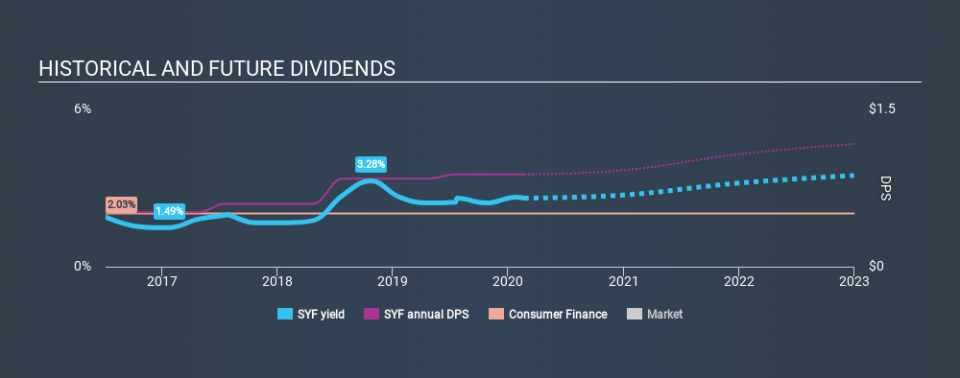Why Dividend Hunters Love Synchrony Financial (NYSE:SYF)

Today we'll take a closer look at Synchrony Financial (NYSE:SYF) from a dividend investor's perspective. Owning a strong business and reinvesting the dividends is widely seen as an attractive way of growing your wealth. On the other hand, investors have been known to buy a stock because of its yield, and then lose money if the company's dividend doesn't live up to expectations.
With a 2.6% yield and a four-year payment history, investors probably think Synchrony Financial looks like a reliable dividend stock. A 2.6% yield is not inspiring, but the longer payment history has some appeal. The company also bought back stock during the year, equivalent to approximately 18% of the company's market capitalisation at the time. Some simple analysis can reduce the risk of holding Synchrony Financial for its dividend, and we'll focus on the most important aspects below.
Explore this interactive chart for our latest analysis on Synchrony Financial!
Payout ratios
Companies (usually) pay dividends out of their earnings. If a company is paying more than it earns, the dividend might have to be cut. So we need to form a view on if a company's dividend is sustainable, relative to its net profit after tax. Synchrony Financial paid out 15% of its profit as dividends, over the trailing twelve month period. We like this low payout ratio, because it implies the dividend is well covered and leaves ample opportunity for reinvestment.
We update our data on Synchrony Financial every 24 hours, so you can always get our latest analysis of its financial health, here.
Dividend Volatility
Before buying a stock for its income, we want to see if the dividends have been stable in the past, and if the company has a track record of maintaining its dividend. Looking at the data, we can see that Synchrony Financial has been paying a dividend for the past four years. The dividend has not fluctuated much, but with a relatively short payment history, we can't be sure this is sustainable across a full market cycle. During the past four-year period, the first annual payment was US$0.52 in 2016, compared to US$0.88 last year. This works out to be a compound annual growth rate (CAGR) of approximately 14% a year over that time.
The dividend has been growing pretty quickly, which could be enough to get us interested even though the dividend history is relatively short. Further research may be warranted.
Dividend Growth Potential
Dividend payments have been consistent over the past few years, but we should always check if earnings per share (EPS) are growing, as this will help maintain the purchasing power of the dividend. It's good to see Synchrony Financial has been growing its earnings per share at 15% a year over the past five years. Earnings per share are growing at a solid clip, and the payout ratio is low. We think this is an ideal combination in a dividend stock.
Conclusion
When we look at a dividend stock, we need to form a judgement on whether the dividend will grow, if the company is able to maintain it in a wide range of economic circumstances, and if the dividend payout is sustainable. We're glad to see Synchrony Financial has a low payout ratio, as this suggests earnings are being reinvested in the business. We were also glad to see it growing earnings, although its dividend history is not as long as we'd like. Synchrony Financial has a number of positive attributes, but falls short of our ideal dividend company. It may be worth a look at the right price, though.
Companies that are growing earnings tend to be the best dividend stocks over the long term. See what the 12 analysts we track are forecasting for Synchrony Financial for free with public analyst estimates for the company.
We have also put together a list of global stocks with a market capitalisation above $1bn and yielding more 3%.
If you spot an error that warrants correction, please contact the editor at editorial-team@simplywallst.com. This article by Simply Wall St is general in nature. It does not constitute a recommendation to buy or sell any stock, and does not take account of your objectives, or your financial situation. Simply Wall St has no position in the stocks mentioned.
We aim to bring you long-term focused research analysis driven by fundamental data. Note that our analysis may not factor in the latest price-sensitive company announcements or qualitative material. Thank you for reading.

 Yahoo Finance
Yahoo Finance 
